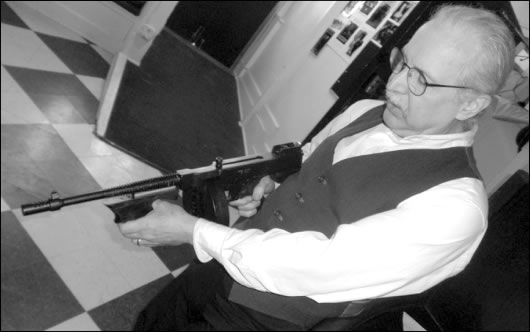BY SERGEY KADINSKY
The gray-colored tenement at 80 St. Mark’s Place has always been a local curiosity, spanning the history of its neighborhood. After almost a half century of ownership by the Otway family, the building’s shady past is being brought to light as the Museum of American Gangster.
“The place itself is an artifact of organized crime,” said owner Lorcan Otway. “This is the perfect place for it.”
Better known as the home of Theatre 80 St. Mark’s, the building previously served as a speakeasy, complete with a bar, tunnels and secret doors. In 1964, actor Howard Otway bought the building from gangster Walter Scheib, and discovered two safes with $2 million in gold currency inside.
“My father called him, and he took the money,” said Otway. “The safe also had beer bottles and World War II Army-issue matches.”
Howard Otway gave the building new life as a theater, with its own sidewalk walk of fame. In the years since, his son continued discovering Prohibition-period items throughout the building, and compiling his own collection of old newspapers, bottles and models of rum-running vessels.
“It probably wasn’t Scheib’s money,” said Otway. “People were going back to that safe as late as 1945. And that’s the mystery our visitors can try solving, as they explore the museum.”
Otway, who is a Quaker, does not apologize for opening a museum that may appear to some as glorifying crime.
“Organized crime is the middle ground between control of vice and liberty,” said Otway. “John Hancock smuggled molasses, trafficked in humans, and Sam Adams was a brewer. They protested the sugar tax.”
Otway promises visitors that the experience of his new museum will be authentic, and representative of the East Village’s history.
“There’s a large proliferation of fake speakeasies in the city,” said Otway. “People want something real.”
At the March 7 public preview, some of the visitors spoke of their own family ties to the Prohibition era and organized crime.
“I did some genealogy on my family,” said Upper West Sider Kathy Gaulthier. “My grandfather was shot by the mob in a similar bar. It was during the Al Capone period.”
“My grandfather was a longshoreman in Red Hook,” said Camille D’Agosto, of Brooklyn. “I cannot say anything further about this.”
For the visit, D’Agosto and her husband, Donato, and son Johnnie donned Al Capone shirts, recalling the one-time Brooklyn resident.
Other local residents knew the building for its theater, which currently hosts “Happy in the Poorhouse,” by The Amoralists.
“I used to come to this theater all the time,” said tour guide Mark Grant. “This is where ‘You’re a Good Man, Charlie Brown’ had its start. It’s Off-Off-Off-Broadway.”
The museum will continue to share the building with the theater and apartments above, including the home of Otway’s mother, Florence; she turned 90 on the museum’s preview day, and lives in an apartment that once housed Leon Trotsky. Born three months into Prohibition, Florence said her parents were active participants on the speakeasy scene.
“It’s very interesting to work here,” said Theatre 80 house manager Ingrid Blanco. “You see and feel history all the time.”
At Prohibition’s height, the city had some 3,000 speakeasies, with back entrances, tunnels and alcohol-producing equipment. The basement of the St. Mark’s Place row house has tunnels leading to an alley, as well as a storage room and a telephone to provide notice whenever authorities approached.
The collection’s centerpiece in the basement is the safe, with its random, period items.
“We want the visitors to be involved in the history of the museum,” said co-founder Eric Ferrara. “We are lucky this is an authentic speakeasy.”
Plans for an opening date will be announced later this spring. For more information on the museum, visit www.moagnyc.org .






































